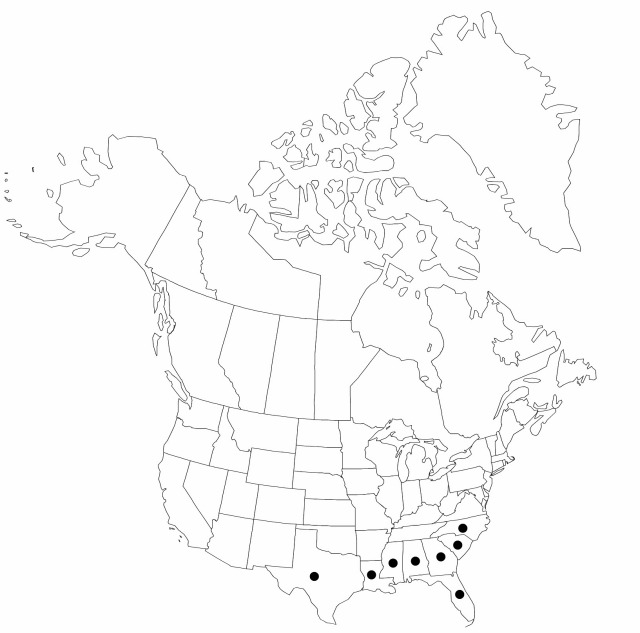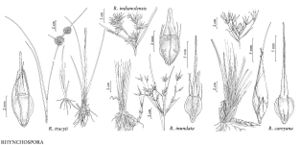Difference between revisions of "Rhynchospora tracyi"
Trans. New York Acad. Sci. 11: 84. 1892.
FNA>Volume Importer |
imported>Volume Importer |
||
| (6 intermediate revisions by 2 users not shown) | |||
| Line 7: | Line 7: | ||
|year=1892 | |year=1892 | ||
}} | }} | ||
| − | |basionyms={{Treatment/ID/ | + | |special_status={{Treatment/ID/Special_status |
| + | |code=F | ||
| + | |label=Illustrated | ||
| + | }} | ||
| + | |basionyms={{Treatment/ID/Basionym | ||
|name=Ceratoschoenus capitatus | |name=Ceratoschoenus capitatus | ||
|authority=Chapman | |authority=Chapman | ||
| + | |rank=species | ||
| + | |publication_title=Fl. South. U.S., | ||
| + | |publication_place=529. 1860 | ||
}} | }} | ||
|synonyms={{Treatment/ID/Synonym | |synonyms={{Treatment/ID/Synonym | ||
|name=Phaeocephalum tracyi | |name=Phaeocephalum tracyi | ||
|authority=(Britton) House | |authority=(Britton) House | ||
| − | }}{{Treatment/ID/Synonym | + | |rank=species |
| + | }} {{Treatment/ID/Synonym | ||
|name=Schoenus triceps | |name=Schoenus triceps | ||
|authority=Vahl | |authority=Vahl | ||
| + | |rank=species | ||
}} | }} | ||
|hierarchy=Cyperaceae;Rhynchospora;Rhynchospora tracyi | |hierarchy=Cyperaceae;Rhynchospora;Rhynchospora tracyi | ||
| Line 32: | Line 41: | ||
|elevation=0–100 m | |elevation=0–100 m | ||
|distribution=Ala.;Fla.;Ga.;La.;Miss.;N.C.;S.C.;Tex.;West Indies;Central America (Belize). | |distribution=Ala.;Fla.;Ga.;La.;Miss.;N.C.;S.C.;Tex.;West Indies;Central America (Belize). | ||
| − | |discussion=<p>Rhynchospora tracyi frequently forms clones extending for acres by means of its long slender rhizomes. Its wandlike, terete, supple culms, and round-capitate clusters of spikelets suggest a rush more than a sedge.</p> | + | |discussion=<p><i>Rhynchospora tracyi</i> frequently forms clones extending for acres by means of its long slender rhizomes. Its wandlike, terete, supple culms, and round-capitate clusters of spikelets suggest a rush more than a sedge.</p> |
|tables= | |tables= | ||
|references= | |references= | ||
| Line 41: | Line 50: | ||
-->{{#Taxon: | -->{{#Taxon: | ||
name=Rhynchospora tracyi | name=Rhynchospora tracyi | ||
| − | |||
|authority=Britton | |authority=Britton | ||
|rank=species | |rank=species | ||
| Line 55: | Line 63: | ||
|publication title=Trans. New York Acad. Sci. | |publication title=Trans. New York Acad. Sci. | ||
|publication year=1892 | |publication year=1892 | ||
| − | |special status= | + | |special status=Illustrated |
| − | |source xml=https:// | + | |source xml=https://bitbucket.org/aafc-mbb/fna-data-curation/src/2e0870ddd59836b60bcf96646a41e87ea5a5943a/coarse_grained_fna_xml/V23/V23_355.xml |
|genus=Rhynchospora | |genus=Rhynchospora | ||
|species=Rhynchospora tracyi | |species=Rhynchospora tracyi | ||
Latest revision as of 20:40, 5 November 2020
Plants perennial, clonal, to 120 cm; rhizomes scaly, slender, less than 2 mm thick. Culms erect, leafybased, wandlike, nearly terete, multiribbed. Leaves ascending or erect, longest nearly equaling culm; principal blades linear, involutecylindric, to 3 mm wide, apex tapering, subulate. Inflorescences terminal, heads 1–4, dense, macelike, 1–1.5 mm thick; involucral bracts leafy, proximalmost overtopping inflorescence. Spikelets greenish, lanceovoid, 5–6 mm, apex acuminate; fertile scales boat-shaped, 5 mm, apex acute to shortacuminate, midrib slightly excurrent or not. Flowers: perianth bristles 6, exceeding fruit body, antrorsely barbellate. Fruits 1 per spikelet, 6–8(–8.7) mm; body pale greenbrown, laterally compressed, obcordiform, 2.5–3(–4) mm, margins thick, rounded, not crimped, apex barely exserted, setulose, surfaces nearly plane, minutely cancellate (latticed); tubercle (style base) linear, angled, 4–6 mm, much narrower than fruit summit, setulose.
Phenology: Fruiting late spring–fall.
Habitat: Emergent in shallows of cypress domes, marshes and swales, ditches and ponds
Elevation: 0–100 m
Distribution

Ala., Fla., Ga., La., Miss., N.C., S.C., Tex., West Indies, Central America (Belize).
Discussion
Rhynchospora tracyi frequently forms clones extending for acres by means of its long slender rhizomes. Its wandlike, terete, supple culms, and round-capitate clusters of spikelets suggest a rush more than a sedge.
Selected References
None.
